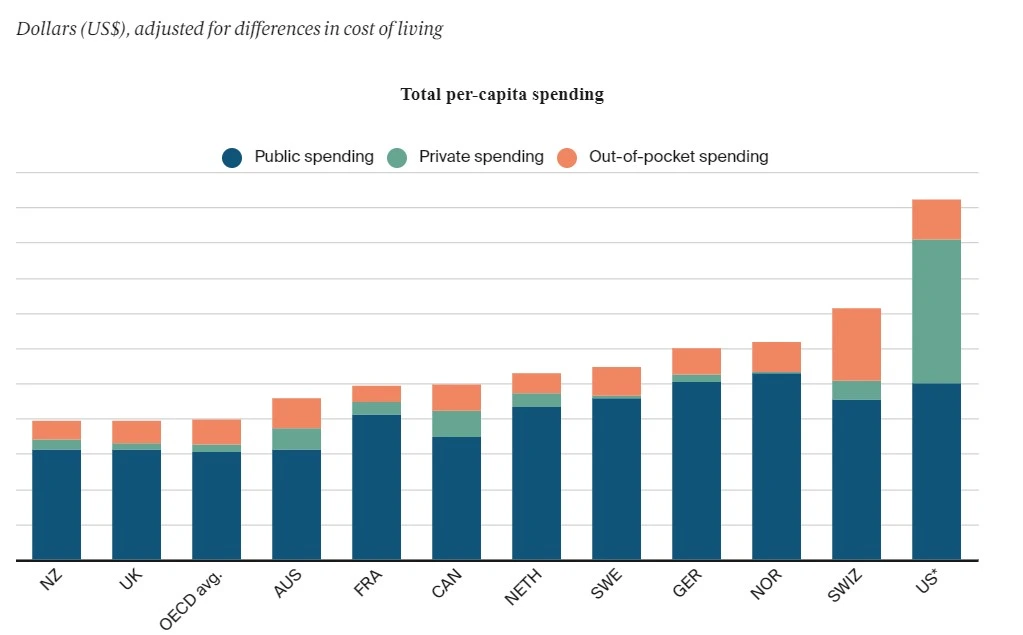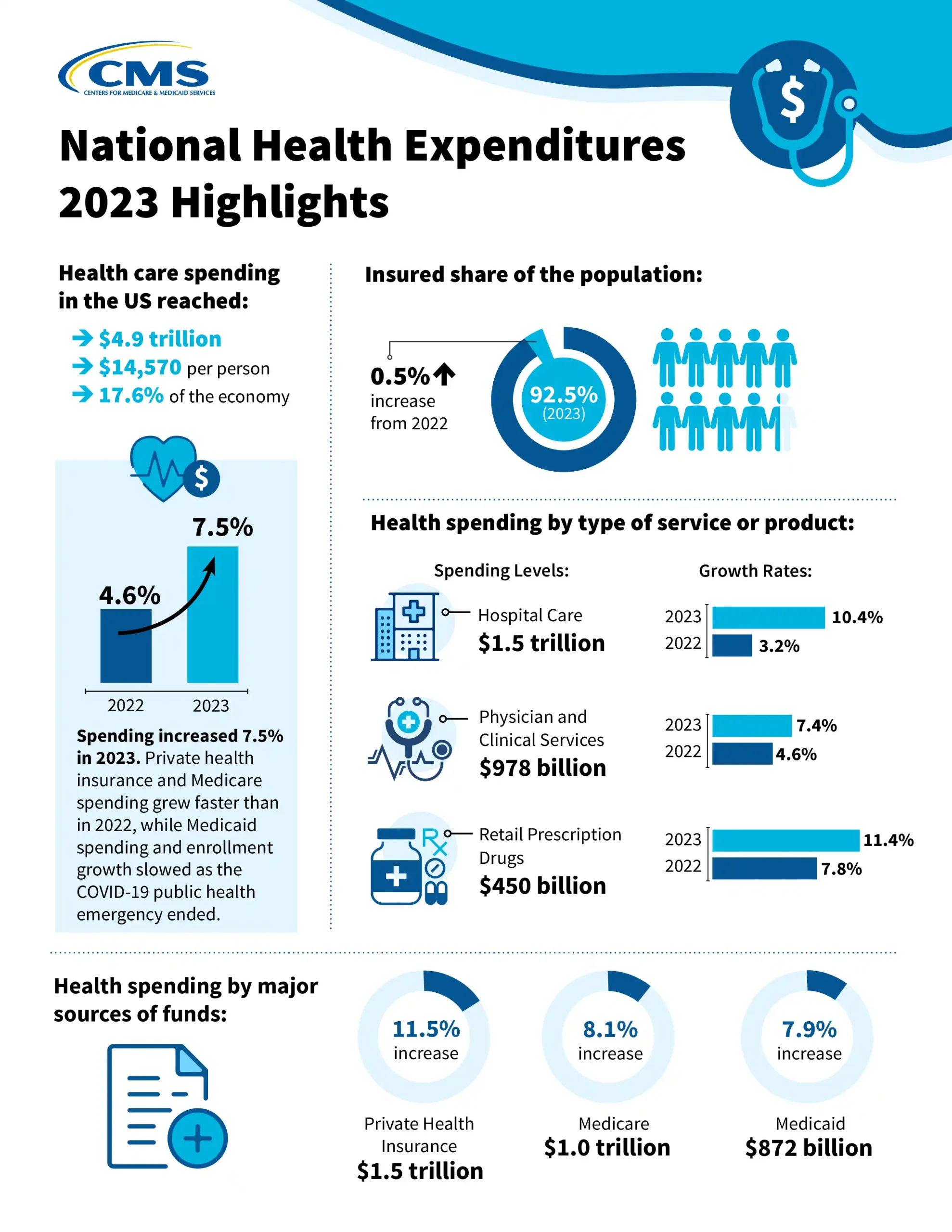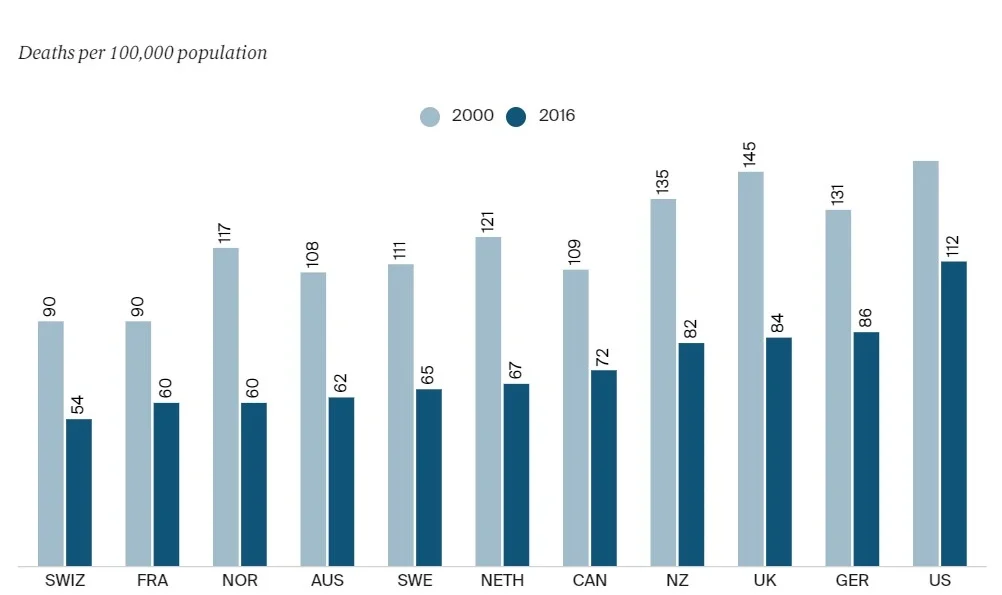Health is everything. It is one of the only things money can’t buy. Yet, people invest so much in their health. With so many options for medical care available, it can be hard to understand the best way forward.
The US has the highest per capita expenses for public healthcare ($11,189.79) and the second highest per capita expenses for private healthcare ($2,242.57) in the world. While Americans are spending so much on their wellbeing, it begs the question – which option is a better choice between private vs public healthcare?
Both private and public healthcare have their benefits, but there are many factors that make them different. From quality of care and costs to access and insurance coverage, we’re here to debate both sides and help you get a clearer picture.
In this blog, we’ll explore the pros and cons of each system and offer the best solutions. Should you opt for private healthcare packages like membership medicine or go for public healthcare options? Let’s jump in and start dissecting the topic.
What Is Public Healthcare?
Public healthcare is defined as a government-managed system funded primarily through taxes. Its main goal is to give healthcare access to all of its citizens no matter their income level.
Here’s how public healthcare works:
- Its funding is collected through taxes and used to subsidize treatments for patients,
- It covers general medical services like doctor visits, hospital stays, and more.
- It uses public hospitals and clinics to manage huge volumes of patients.
As of 2020, Americans are experiencing worse health outcomes than any other high-income nation. Is it the fault of public healthcare? Well, public healthcare systems are designed to be inclusive but usually face problems like long wait times and resource limitations.
If a patient doesn’t want to go through the hassle of waiting weeks for an appointment, they have the option to cover their health needs with private medical care.

What Is Private Healthcare?
Private healthcare is a system that works outside of government management. It is funded through private insurance or direct payments.
Here’s how private healthcare usually works:
- Private healthcare providers operate independently, which allows them to offer flexible services, often through subscription medical care.
- Patients get high-quality medical care with shorter wait times and access to diverse specialists.
- Many private clinics like concierge medicine practices have the means to offer specialized and individualized care.
Ultimately, patients who have insurance coverage or get executive health programs as a part of their corporate benefits packages get to experience faster and better medical care than those who rely on public hospitals.
But nothing is so black and white. There are benefits to both healthcare systems, and it is up to the individual patient to choose which model fits their needs the best.
Key Differences Between Private vs Public Healthcare
When looking at private vs public healthcare, there are many differences to consider. Each system operates in its own way and has a specific type of impact on patient care. Let’s talk about the 4 main things that make public and private healthcare different.
1. Funding Sources
One of the biggest differences between private and public healthcare systems is their funding sources. Public often means free or affordable care, while private usually makes people think of huge costs. Are these stereotypes true?
Well, public healthcare is funded by taxes, and it helps virtually all citizens of a country take care of their health needs. This model makes sure that coverage is widespread, but it comes with its challenges like limited budgets and other resource constraints.
On the other hand, when it comes to private vs public health insurance, we know that private clinics are funded by:
- Private insurance plans
- Employer benefits
- Out-of-pocket payments
For example, personalized concierge medicine plans can cost anywhere from $4,000 upwards of $50,000 depending on the scope of services. While it can be daunting to pay such a high price, these payments allow private systems to allocate resources more flexibly. Ultimately, patients who can afford it get more efficient and personalized care.
2. Access and Availability
Another major difference between private vs public healthcare is their accessibility. Public healthcare is meant to be universally accessible, offering patients essential health services.
Everyone can agree that public healthcare is a cornerstone of equitable healthcare. However, this also translates to long wait times and limited availability of non-essential treatments because of high demand.
On the flip side, private healthcare doesn’t have as high of a demand, which allows providers to serve their patients faster, prioritizing appointments and smooth processes. Some premium clinics even offer 24/7 global access to physicians. It is one of the biggest benefits of concierge medicine, but its access is limited to those who can afford it.
3. Control and Oversight
Public healthcare systems are heavily regulated by the government. This almost guarantees that patients get standardized care and hospitals stay accountable. However, it can also heavily slow down decision-making processes and innovation.
When looking at private healthcare, one of the first words that comes to mind is independence. Clinics operating in this system are in a market-driven environment where innovation and better service quality are driven by competition.
4. Provider Networks and Facilities
The last difference we want to touch upon is the provider networks and facilities powering public and private healthcare.
Public healthcare usually relies on huge networks of generalized providers, which value efficiency over personalization. While patients get access to a broad range of services, they may miss out on specialized care or amenities that private healthcare providers offer.
If a patient is looking for higher quality of care, the boutique-style services from specialized providers within private healthcare systems might be a better choice. From state-of-the-art facilities to tailored patient experiences and even travel risk management, private medicine providers go above and beyond to meet their patients’ needs.
4 Challenges of Private Healthcare
While private healthcare delivers better patient outcomes and streamlined experiences for patients, it doesn’t come without its faults. Choosing a private clinic to cover your health needs has its considerations. So, keep the following issues in mind when making your decision.
1. Cost Considerations for Premium Care
Better services have higher costs. This relates to private healthcare packages as well. While you get premium-quality medical services, advanced treatments, and access to top-tier specialists, it all comes at a cost.
Unfortunately, regular old health insurance usually doesn’t cover premium healthcare like concierge medicine. The price is covered either by private insurance, your corporate health package, or is paid out of your pocket. Ultimately, the price tag might not be worth it for everyone.
2. Selective Accessibility
The stereotype is true – premium healthcare is a selective deal. Private healthcare systems are often limited in access to those who have financial constraints or lack comprehensive insurance plans. This creates inequities in care.
However, it is this selectivity that allows private health care systems to offer shorter wait times and a more personalized approach to each and every patient.
Additionally, this doesn’t mean that your whole family won’t get to benefit from premium healthcare. For example, there are concierge family medicine plans that cover the health of all your loved ones.
3. Focus on Specialized Services
While your concierge doctor is there to cover all your health needs, private clinics can put a bigger emphasis on high-quality, specialized treatments.
This may not always align with broader public health needs, but it is beneficial for many groups of patients like:
- Those who suffer from chronic illnesses
- Executives who face cardiovascular disease risks due to stress
- Patients focused on treating specific issues they face because of their genetic predisposition
4. Integration with Broader Healthcare Systems
Lastly, let us point out that private healthcare systems sometimes operate independently of public systems. This means that if you use both private and public healthcare, integrating the two services can become tough.
While transitioning between providers from these two worlds comes with its innate challenges, private clinics are usually able to cover most of your health needs through the use of services like concierge primary care.

4 Challenges of Public Healthcare
Public healthcare comes with its inherent issues as well. To give you a fair comparison between private vs public healthcare, let us also tell you about the hurdles you might face in the public health system and how they can affect your experience and outcomes as a patient.
1. Overwhelming Patient Demand
Offering universal public healthcare to all citizens creates a patient demand that medical facilities fail to meet. This means that patients and providers see overcrowded waiting rooms and long delays for non-urgent treatments like elective surgeries way too often.
If you are a user of public healthcare, you’ve likely experienced the frustration of waiting weeks for a 20-minute appointment that doesn’t result in a comprehensive treatment of your problem. This is one of the biggest issues that public healthcare systems face.
2. Insufficient Resources
The US spent $4.9 trillion on health care in 2024, which was 17.6% of its GDP. Yet resources for covering public health needs are still constrained. These resources don’t seem to be limited, but hospitals stay understaffed and still use outdated medical equipment.
With insufficient funding, patient care is the one thing that suffers most, particularly in underserved areas. As a patient, a sense of inequity is inevitable.
3. Regional Disparities in Care Quality
The quality of public healthcare can vary dramatically from coast to coast. Depending on a patient’s geographical location, they will get different outcomes and experiences of medical care.
Urban centers usually have better-equipped facilities and more experienced staff, while rural areas are left struggling with insufficient resources and infrastructure. While this can be true of private healthcare systems as well, the volatility of patient care in public healthcare is way more apparent.
4. Bureaucratic Inefficiencies
Unlike private clinics, public healthcare providers are usually burdened by complicated administrative processes. As a patient, you may experience frustrating delays when:
- Obtaining referrals
- Scheduling appointments
- Processing claims
- And more
This disjointed experience has led to the stereotype that quality care is for the rich. Nevertheless, there are new technologies and ways to overcome all the challenges of public healthcare.

Solutions to Address Healthcare Challenges
The hurdles that both private and public healthcare systems face have their solutions. Practical innovations like telemedicine and care coordination have the power to make modern healthcare simply better. So, let’s talk about some of them and discuss how they can be applicable to private vs public healthcare.
Improving Accessibility Through Telemedicine
Telemedicine uses digital tools like email, phone, or online platforms to connect patients with doctors. This works no matter the patient’s location, allowing them to get medical care anywhere, anytime.
One of the biggest pros of private healthcare is the widespread use of telemedicine. It essentially eliminates logistical and geographic barriers, which is one of the many benefits of telemedicine.
While it’s not so widespread in public healthcare, it could be a great use of resources that reduces long wait times and the need to travel to hospitals.
Balancing Costs with Quality
The next solution is the incorporation of subscription-based care models that can help providers predict their costs better while maintaining a high quality. It’s beneficial for both patients and doctors because it reduces financial uncertainty. In other words, it would work like a pre-paid plan that ensures you can get healthcare any time you need it.
When looking at private healthcare vs public healthcare, membership-based plans give patients premium care without excessive costs associated with the private systems. It’s a win-win deal.
Reducing Inequities in Service Delivery
To make service delivery more equal across different geographical locations and populations, hybrid healthcare models can be used. They are inclusive like public systems and efficient like private care.
No matter a patient’s income level or region, high quality services can become available to them. This not only improves patient outcomes and gives patients a wider range of services but also makes costs more manageable.
Integrating Care Coordination
Care coordination is another one of the solutions that can make healthcare holistic for patients. Whether they are transitioning between different providers or systems, doctor referrals from established networks will give them the care they need by connecting them to the specialist they need it from.
Healthcare systems that use an integrated model can take patients through diagnosis, treatment, follow-ups, and preventive health. At the end of the day, they pass through a smooth healthcare journey that keeps them healthy and happy.
Personalized and Preventive Care Models
Saying goodbye to the one-size-fits-all approach to healthcare is the last solution we want to discuss. Instead, using care models like personalized concierge medicine can help providers focus on proactive medical solutions that fit a patient’s individual needs.
With a preventive health approach, patients become able to deal with potential issues before they escalate. This way, they won’t face more complicated treatments and essentially need healthcare in the long run. As a result, patients experience simply better outcomes.
Conclusion
The ongoing debate around private vs public healthcare is a tough nut to crack because both systems have their benefits and challenges. While public healthcare is inclusive and universal, the private model brings personalization and efficiency to the table.
Solving the challenges of these systems will take more than just one innovation, but technologies like telemedicine are on track to bridging the gap between affordable and premium medicine.
Combining accessibility, cost-efficiency, and personalized care is key to the future of healthcare. In the meantime, solutions like concierge medical services that deliver better healthcare tailored to your needs are just what the doctor ordered.
If you’re ready to experience better healthcare, don’t hesitate to explore our membership plans for individuals, families, and executives. Let us tell you how we can transform your health journey.
FAQs About Private vs Public Healthcare
1. Can patients use both private and public healthcare systems?
Yes. Depending on your needs and circumstances, combining the two systems for the benefit of your health journey is a possibility. Many patients choose to use public healthcare for routine or emergency services and private healthcare to get specialized or faster treatments. If your insurance doesn’t cover private care, this integrated approach can be financially beneficial for you as well.
2. What is the role of telemedicine in addressing healthcare challenges?
Telemedicine eliminates many barriers to healthcare access. It makes virtual consultations possible, which means that patients don’t have to travel to their healthcare providers or wait in long lines. This technology also delivers healthcare to those living in remote or underserved areas, giving them the possibility to talk to medical professionals from the comfort of their own homes.
3. How do subscription-based healthcare plans work?
Subscription-based healthcare packages give patients comprehensive health services for a fixed monthly or annual fee. Premium providers also work with yearly retainers. With this model, healthcare costs become predictable and the ambiguity that comes with traditional care is essentially eliminated.
4. How do private healthcare providers ensure quality and personalization?
Private healthcare providers prioritize quality of care and patient outcomes over the number of patients served. Concierge doctors can see fewer patients and hold longer appointments, truly diving into the root of the health problem and taking personal details and medical history into account.
5. What are the cost differences between private and public healthcare?
Private healthcare providers tend to be more expensive, but they give quicker and more personalized access to medical services. On the other hand, public healthcare is more affordable or sometimes free, but it comes with longer wait times and limited choices for treatments or specialists.


